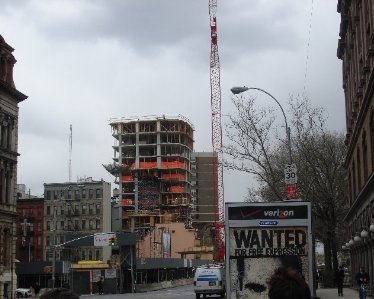East Village- Evolution
From Decoding New York
| Introduction |
| The East Village |
| * Evolution |
| * Here v. There |
| * Economy |
| * What's Real |
| Bay Ridge |
| * Evolution |
| * Here v. There |
| * Economy |
| * What's Real |
| Comparison |
| * Photo Gallery |
| * Sources
|
The East Village was one of the earliest settled areas of Manhattan. In the 1600s, it was part of the plantation of Peter Stuyvesant, Director-General of New Amsterdam, who wanted a home away from the military compound of the main colony in lower Manhattan. The Bowery gets its name from the Dutch bouwerie, or farm; Stuyvesant's tombstone can be seen in the foundation of the church from which St. Mark's Place takes its name. Because of its location, the East Village -- the northern section of the Lower East Side -- became a longstanding home of working-class immigrant groups, many of which moved on without leaving signs of their presence. By the late 1800s, the East Village's German population earned it the name Kleindeutschland, but by World War One, Yorkville had replaced it as Manhattan’s main German neighborhood, and there are few reminders of that population. The Eastern European legacy remains visible; one can find the Ukrainian National Home on Second Avenue, and pierogi, blintzes, and egg creams are still readily available. The Ukrainian Museum, dedicated to "the cultural legacy of a people whose thousand year journey through history abounds with grand, dramatic, turbulent and exciting events," moved into a new building on East 6th Street in 2005.[1] In the southeastern area of the neighborhood there are many small parks and gardens in what used to be abandoned lots, often accompanied by vibrant murals, a far cry from the tenements of the early 20th century.
While the earliest immigrant groups have not left many obvious traces, their effect on the neighborhood can still be felt. Some early immigrants played pivotal roles in shaping what would become the East Village. Peter Cooper was a Dutch workingman's son who had barely a year of formal education, and never learned how to spell. [2] Despite this, he excelled in life, and was a successful manufacturer (of iron and steel) and inventor. He never forgot his humble roots, and founded Cooper Union which opened at Astor Place and Fourth Avenue in 1859, the only free private college in the United States. The idea was to not let the hidden talents of the children of immigrants and the working class to go to waste because of a lack of economic opportunity. It was here that Abraham Lincoln gave the speech that helped secure his nomination as the Republican candidate in the 1860 presidential election.[3] The school's Great Hall was also the site of other important speeches and performances by artists and politicians such as Steve Reich, Joseph Campbell, Rudolph Giuliani,and Hugo Chávez. This block also has the dubious honor of being the site of New York’s first recorded mafia hit; it was here that Carlo Quarteraro stabbed Antonio Flaccomio to death for cooperating with a police investigation into a counterfeiting ring.

Every facet of the neighborhood is characterized by change with avant garde music and art among the most vibrant elements. Gang rivalry between ethnic groups characterized changes in power and influences in the underground of the community. Single events can also change the face of ethnic identity in the East Village; perhaps the most dramatic example is the General Slocum Disaster [4]. On June 15, 1904, a Sunday church outing on a ship took a horrific turn when the boat burned and over a thousand people were killed, most of them German women and children. The incident took an enormous toll on the German community and within a year, many residents dispersed to other neighborhoods and Little Germany faded away.
One of the subtlest changes, but one which has affected the neighborhood a great deal, came with the migration of artists from an increasingly gentrified Greenwich Village in the 1950s. As the neighborhood started to become trendier, the term “East Village” was coined for what had previously been simply the northern part of the Lower East Side. Some consider this to be just a real-estate marketing ploy; if so, it’s a ploy come true. The neighborhood is now a distinct entity, and after it separated from the Lower East Side, it started down the road to gentrification. This is, unsurprisingly, most evident along the southwestern area, which borders Soho, Noho, and Greenwich Village, all thoroughly gentrified themselves. The neighborhood, whose low rents attracted the working-class for so long, is now steadily increasing in cost. Real estate is accordingly snapped up wherever possible, with many parking lots and gas stations given over to development. The all-glass facades of modern apartment buildings now stand alongside the historic tenements, which are themselves often renovated on the inside. New York University has a strong presence in the area, including dorms at the intersection of the Bowery and Bleecker Street. As low-rent, 50-years leases expire for small shopkeepers, and rents are increased to unafforable levels, the door is opening for even greater change.
